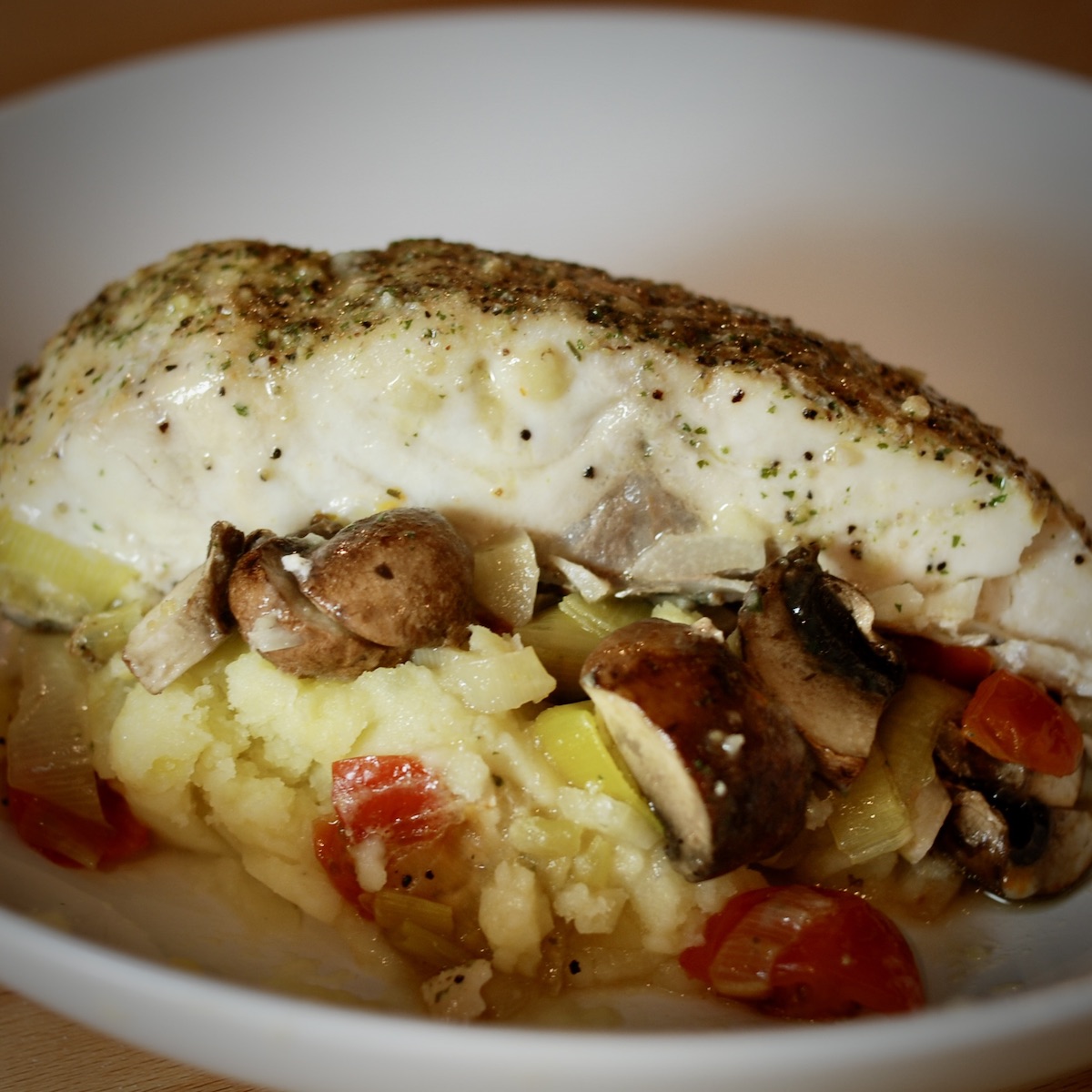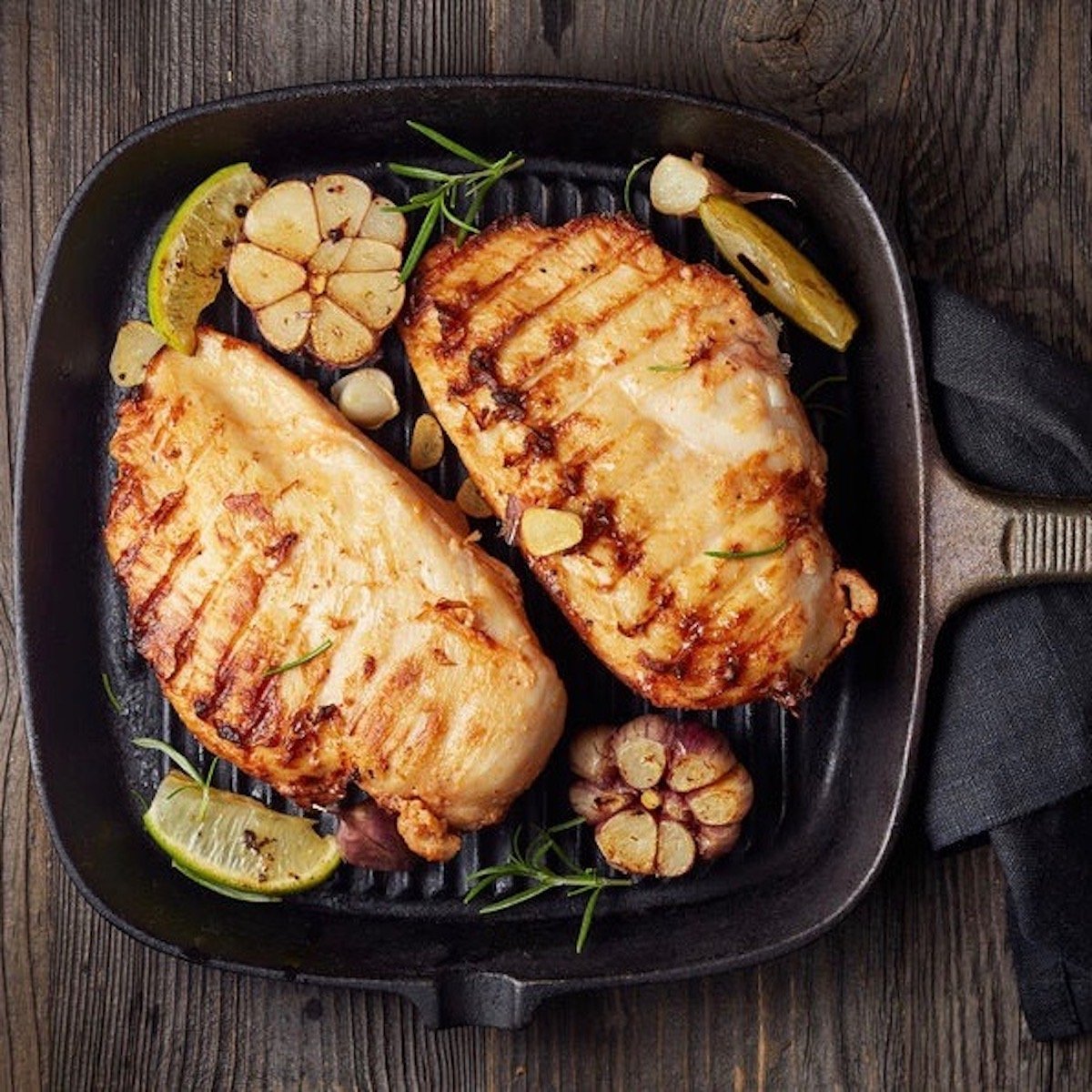Common Mistakes Home Cooks Make When Pan Roasting
Now that we have discussed How NOT to Roast your favorite foods, let’s talk about one of my favorite cooking techniques – Pan Roasting. Pan roasting is a chef’s technique that only starts to come out of the professional kitchen and into the home kitchen.
In pan roasting, meat is first seared in a hot pan with a bit of oil on the stovetop and then finished in the oven at moderate heat. This two-step cooking process works wonders on thicker cuts of meat, yields a finished product with a nice crust on the outside, and is moist and juicy on the inside, all at a time cost of well under thirty minutes.
Pan roasting is best for medium-sized cuts of meats – chops over 1 ½” thick. We’re talking about pork loin, thick beef tenderloin medallions, chicken quarters, etc.
These are cuts that would burn on the outside before being done on the inside if trying to use the conductive heat of the stovetop and cuts that would not form a good crust on the outside before the internal temperature is reached if just oven-roasting. Pan roasting gives you the best of both worlds—a crust and an interior that is finished to your liking.
Like all cooking techniques, there is a right and wrong way to pan roast. Let’s look at some common mistakes.
Mistake #1: The Wrong Cut of Meat
While pan roasting is a great cooking technique for various meats, it is not a one-size-fits-all cooking method. If you’ve ever tried to pan-roast brisket, you probably ended up with a chewy, inedible mess.
The Fix – Using the Right Cut
Pan Roasting is a high-heat dry cooking method. As such, the cuts that will work best for pan roasting are lean – cuts that do not have too much connective tissue and short muscle fibers. In general, these cuts are found farthest from the “hoof and horn” of the animal.
Cuts from the center, including rib roasts, short loin, and sirloin, work well. Tougher cuts, such as cuts from the chuck, round, shank, and brisket, benefit from an initial sear but then need long, slow cooking with wet heat (braise, stew) to break down the collagen and into gelatin.
This is why using an expensive cut of meat to make pot roast wastes money. It’ll be dry and tasteless since it lacks the gelatin to keep it moist.
Conversely, cooking a tougher, cheaper cut using a dry heat cooking method is also a good use of money. The result will be meat with a beautiful sear, which is chewy, rubbery, and impossible to cut. Either way, you end up with an inedible mess.
Mistake #2 Cold Meat
Have you ever taken a piece of bologna from the fridge and thrown it in a pan to make a grilled bologna sandwich? Have you seen how it curls up when it hits the pan?
How about this: have you ever gone out and stood in the cold for a few minutes without a jacket? Notice how your muscles tense up?
These are two examples of what happens to cold meat– It curls up and toughens. This happens to cold meat when you put it in a hot pan.
This inhibits a good, even sear, can lead to a tougher finished product, and cools the pan down so that the meat is more likely to steam rather than sear.
The Fix – Let it Rest
Your muscles relax when you come in from the cold and warm up. The same thing happens to meat. You must take the meat from the refrigerator to let it approach room temperature before putting it in the hot pan.
The muscle fibers in meat at room temperature are more relaxed and pliable. Water is forced out of the muscle fibers at refrigerator temperatures. And where does the water go? It hangs out between the muscle fibers, ready to drain away when the meat hits the pan.
Letting the meat come to room temperature allows the muscle fibers to reabsorb that water, keeping it where it belongs: in the meat instead of in the pan.
Mistake #3: Using the Wrong Pan
How often have you tried to sear something on the stove only to have it burn instead? How often have you wanted to put a pan in the oven but couldn’t because of its handle?
Using a pan made of thin metal, even one with a copper bottom does not allow for even heating on the stove, creating hot spots and increasing the likelihood of burning the food and warping the pan.
Most of these pans have a plastic handle that can melt in the oven.
The Fix – The Right Pan
Since pan roasting is a high-heat cooking method followed by a roast at medium heat, you need a pan that can
a) stand up to high heat on the stove and
b) go into the oven.
The ideal pan for this cooking method is cast iron. Cast iron heats evenly, and once it gets hot, it stays hot. A cast iron pan has a cast iron handle that can withstand oven temperatures.
Other likely candidates for this method include heavy-bottomed skillets or sauté pans with metal or heat-resistant composite handles. Choose pans with an aluminum core sandwiched by stainless steel.
*Do not use a non-stick, Teflon-coated pan for high-heat cooking. The coating can give off toxic fumes at high heat, and if your pet bird is in the kitchen watching you cook, it will keel over and die from the fumes. Honest.

Mistake #4 The Cold Pan
Sometimes, when trying to make a quick and nutritious meal at the end of a long day, we tend to rush some steps. We put a pan on the stove and throw in the meat. And it sticks and sort of sits there and steams instead of searing.
A friend asked for and received high-end cookware for wedding gifts. They said they hated it because their food sticks to the pans. If you’re one of those people, read on.
The Fix – Heat it Up
When cooking on the stovetop, it is imperative to heat the pan and then heat the oil before introducing the meat.
When you put a piece of meat in a hot pan, the temperature of the pan drops because of heat transfer. This temperature drop is exacerbated if your meat is cold, so take the meat out of the refrigerator a half-hour or so before cooking to let it temper. The hotter you have the pan, the less time it will take for the heat to recover to the optimum searing temperature (medium-high).
Here’s what you do: put the pan over medium-high heat for five minutes. Drizzle in neutral oil, such as canola or peanut, and swirl to coat the pan.
Wait until the oil starts to smoke, pat off the meat (dry is better), season with some salt (save the pepper for later—it might burn in the pan), and put the meat in the pan.
Please don’t move it for a minute or two. When the sear is finished, the meat will release from the pan, so don’t try to move it if it’s stuck. It will unstick itself when it is ready. Turn the meat and sear the other side before putting the pan in the oven.
P.S. Once I taught my friend to preheat her pans, her sticking problem magically disappeared, and she loves her pans!
Mistake #5 Medium heat
Many of us need to be more confident when using high heat. We think that high heat is for the grill outside; that high heat cooking inside will make the smoke detector go off and burn our food.
While this can be the case if you’re not paying attention, there are some excellent reasons to use higher heat to achieve a good sear.
The Fix – Turn up the heat
For meat to get the optimum, deep brown-but-not-black sear that gives us so much flavor, it has to be exposed to temperatures between 300° and 500 °F.
It should also be done quickly, and starting at a lower temperature will let your meat steam instead of sear. If you’re worried about the smoke detector, open a window, crank up the heat, watch carefully, and turn the meat when it has reached the desired color.
Mistake #6 The Cold Oven
You’ve worked hard to get a good sear on the meat using high heat. You think, “Wow, that was really high heat; I’ll put the oven on at 250°.”
While this will get the job done, everyone is sitting around waiting for dinner to happen.
The Fix – Turn up the Heat
The whole point of pan roasting is to get the food from the stove to the table in a reasonable amount of time. As I said before, a cooler oven will do the job but will take longer.
Put your meat in at 350° F, and remove it from the oven when it is about 5 degrees cooler than the target temperature. The rest will give the meat time to coast to the target temperature and for the juices to redistribute while you make a luscious pan sauce.
Mistake #7: The Burned Hand
I don’t know about you, but I will admit that I have removed a pan from a hot oven, turned to do something else, then turned back to the pan, noticed that the handle was sticking out over another pot, and without thinking, moved the pan.
Then, I get burned. Don’t let this happen to you.
The Fix – A Well-Placed Towel
Professional chefs are used to taking pans out of the oven, so they know how to keep them safe. On the other hand, home cooks are new to the whole pan-from-the-stovetop-to-pan-in-the-oven cooking procedure.
We are going against years of hold-the-pan-by-the-handle training. I can promise you, even if you tell yourself, “This pan is hot. I will be careful,” you can find yourself on autopilot, reaching for the pan to make a sauce.
Take a cue from the professional chefs. Get in the habit of draping a kitchen towel or potholder over the pan. This signals to yourself and others in the kitchen that the pan is hot.
Some manufacturers even make tailored handle covers to slip on once the pan is out of the oven. If you’ve lost yours, please use a towel.
How NOT to Cook Topics |
||
| Introduction | Braise | Roast |
| Start a Recipe | Cook Pasta | Saute |
| Season Foods | Grill | Simmer |
| Bake | Pan Roast | Simmer |
| Boil | Poach | Steam |




